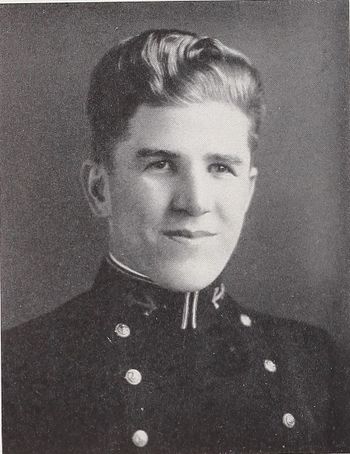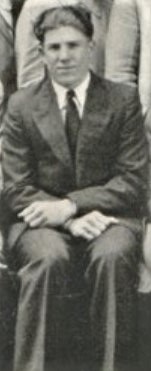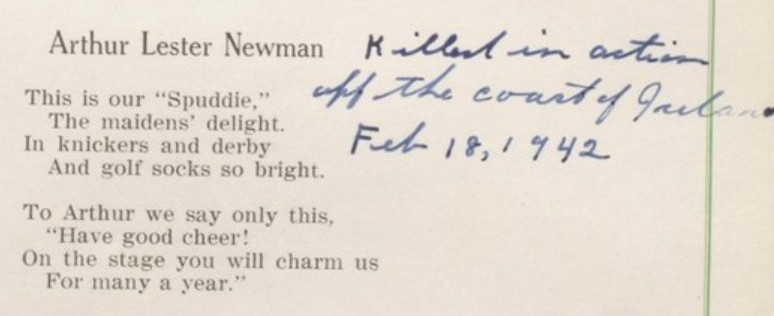ARTHUR L. NEWMAN, LT, USN
Arthur Newman '34
Lucky Bag
From the 1934 Lucky Bag:
ARTHUR LESTER NEWMAN
Seneca Falls, New York
"Art" "Al"
FROM the plow to the tiller, that in short, is the story of this young, energetic, bushy-haired, blond middie who decided somewhat extemporaneously upon his graduation from Mynderse Academy that he would don the blue and gold. Al hails from Seneca Falls and the fact that there were no appointments did not phase this would be "salt" in the least; for as an alternative, he enlisted with the bluejackets and entered the Naval Academy under a Navy quota, sailing free with flying colors after having spent one year in the Service.
From Plebe Summer till now our impressions of him have not changed in the least. One might always find him greeting his many friends with a broad cheerful smile, displaying a large set of teeth.
Although athletically inclined he was forced to take a backseat because of an operation which gave him a late start; nevertheless, he is no radiator hound and we find him working out with the boxing team most winter afternoons. He has become very clever with his dukes.
He has found fun where no one else seems to,—that is to say, Crabtown. On most any liberty he can be found on Prince George Street.
He has succeeded in finding a warm spot in the hearts of his classmates. His high ideals combined with many noble characteristics cannot but help to place him far in his chosen career and incidentally will also give to the Navy a fine gentleman and an excellent officer.
Boxing 4, 3, 2, Class Football. Two Stripes.

ARTHUR LESTER NEWMAN
Seneca Falls, New York
"Art" "Al"
FROM the plow to the tiller, that in short, is the story of this young, energetic, bushy-haired, blond middie who decided somewhat extemporaneously upon his graduation from Mynderse Academy that he would don the blue and gold. Al hails from Seneca Falls and the fact that there were no appointments did not phase this would be "salt" in the least; for as an alternative, he enlisted with the bluejackets and entered the Naval Academy under a Navy quota, sailing free with flying colors after having spent one year in the Service.
From Plebe Summer till now our impressions of him have not changed in the least. One might always find him greeting his many friends with a broad cheerful smile, displaying a large set of teeth.
Although athletically inclined he was forced to take a backseat because of an operation which gave him a late start; nevertheless, he is no radiator hound and we find him working out with the boxing team most winter afternoons. He has become very clever with his dukes.
He has found fun where no one else seems to,—that is to say, Crabtown. On most any liberty he can be found on Prince George Street.
He has succeeded in finding a warm spot in the hearts of his classmates. His high ideals combined with many noble characteristics cannot but help to place him far in his chosen career and incidentally will also give to the Navy a fine gentleman and an excellent officer.
Boxing 4, 3, 2, Class Football. Two Stripes.
Loss
Arthur was lost when USS Truxtun (DD 229) grounded in Newfoundland on February 18, 1942. He was the ship's executive officer.
The book "Standing Into Danger" by Cassie Brown details Truxtun's loss, as well as the loss of USS Pollux (AKS 2) and USS Wilkes (DD 441). The website "Dead Reckoning: The Pollux-Truxtun Disaster" is also devoted to the topic.
Other Information
From Denise Robinson on August 31, 2020 in the "Eastport/Annapolis Legacy of Honor" group on Facebook:
If you travel down Duke of Gloucester, just beyond city hall, to the left, there lies a one-way street named Newman. At the top of the hill, lies St. Mary’s Church, at the bottom, the Fleet Reserve Club. Many drivers use the street as a cut-through to Compromise Street without ever looking up to read the name on the sign. Originally, the street was named Chestnut, but after WWII, the name was changed to honor a man many don't remember or know of, Lt. Arthur Lester Newman.
Arthur Lester Newman (Art) was born on 7 February 1911 on a small farm on Looking Glass Ave just outside Portland, Michigan. He was the second of four children born to Henry Arthur Newman and Anna Larson. Just after his 8th birthday, the family moved from Michigan to a larger farm in Seneca Falls, New York.
Seneca Falls is a small idyllic town in the finger lakes region of New York. It is the birthplace for women’s rights and the inspiration for Frank Capra’s, “It’s a Wonderful Life.” Art grew up surrounded by corn and cabbage fields. He would tide his summers helping his father tend the farm while his heart longed to be on the water. The sea was calling and at an incredibly young age, Arthur knew where he belonged, in the United States Navy.
Unlike many farmers of his time, Art’s father, instead of having his children leave school at a young age to help with the farm, insisted his children graduate from high school and pursue their dreams. Art’s love for reading was noted in his hometown paper. Art realized his destiny lied not in the canals and lakes of New York but the faraway places and oceans he read about.
While attending high school, Art tried to unsuccessfully to gain an appointment to the United States Naval Academy. Undeterred, refusing to give up on his dream of being a part of the proud legacy of the Blue and Gold, he charted a new course to the Academy. After graduating with honors from Mynderse Academy, Art enlisted in the Navy.
After basic training, Art was accepted to the Norfolk Preparatory School. After a year of successful course work, he applied and was accepted to the United States Naval Academy. 12 June 1930- Seaman Arthur L. Newman reported to Annapolis for physical fitness and mental examinations. After passing all exams, Art became 4/C Midshipmen Arthur Lester Newman. He was officially a member of the class of 1934.
It was at the Academy that Midshipmen Newman fell in love with a first-generation Italian American, Maria Theresa Florestano (Theresa). Her dark hair and olive skin were a stark contrast to his blonde hair and fair skin. Theresa was the oldest child of Donato “Flossie” Florestano and Amelia Desantis. Donato was an accomplished musician and composer with the Naval Academy Band. (he would later become a Bandmaster)
Theresa and Art met on a blind date arranged by her sister, Lola. Theresa was practicing piano when Art knocked on the door. Unaware of his arrival, Theresa continued to play. From where he stood, he could not see Theresa’s face, only watch her shoulders sway to the music. It did not matter what she looked like; he was mesmerized by her presence. He whispered to himself, “That’s the woman I am going to marry.”
When they first started dating, Art was 2/C midshipmen and Theresa was an elementary school teacher, a recent graduate from the Maryland Normal School (now Towson State University). The following year, the 1934 Lucky Bag, (USNA Yearbook) records- “On most every liberty he (Art) can be found on Prince George Street.” 102 Prince George Street to be exact, Theresa’s home.
In 1934, the Academy had a rule, every graduate had to wait two years before the Navy would grant permission to marry. After commissioning, Ensign Newman reported to the USS Arizona while Theresa stayed in Annapolis. She taught 3rd grade at Eastport Elementary School.
Spring of 1935, Ensign Newman reported to the USS Biddle in Boston. Instead of just corresponding through letters, they were able to visit each other on long weekends and holidays.
December of 1935 Ensign Newman proposed to Theresa. They were married on 1 June 1936. For the first 3 years of their marriage, they lived at various bases. Art spent most of each year at sea. With war looming and Theresa pregnant, they decided it would be best if she moved back home where her parents could help her care for a new baby.
In April of 1939, their daughter Floranne Hope was born. Since she was born Easter week, they nicknamed her Bunny. Later that year, Art was promoted to Lt.
In the fall of 1941, Lt. Newman was assigned as the Executive Officer of the USS Truxton (DD-229). The destroyer’s main duty: escort ships through the dangerous Atlantic shipping channels and protect them from German U-Boats.
(I apologize for the next section, to tell the story, the times may bounce back and forth a bit.)
15 February 1942, the USS Truxton left Boston for Portland, Maine.
17 February 1942, the Truxton joined the USS Pollux escorting the USS Wilkes from Portland to Naval Station Argentia in Newfoundland. The USS Wilkes, a supply ship, was carrying aircraft engines, bombs, radio equipment, and other military supplies.
The USS Wilkes was designated as the flagship. Due to the recent sinking of another vessel the convoy was ordered to steam without lights, maintain radio silence, and zig-zag. The only communications allowed- navigation transmissions (by light signal).
At departure, the conditions in the Atlantic were noted as slightly rough. Light snow was falling The USS Truxton and USS Pollux were not equipped with radar, so they relied on celestial navigation. Since the Wilkes was the flagship and had radar, they were responsible for plotting the convoy’s course. By 8:00 p.m. the storm increased to gale force winds and was upgraded to a blizzard. With zero visibility it was impossible for the navigator of the Wilkes to plot a course using the stars. Instead, he had to use his last sighting from 6:30 p.m. to chart the course- a method known as dead reckoning navigation.
Unbeknownst to the navigator, he had made an error in his 6:30 sighting. He also failed to calculate the storm’s strong current inland. The convoy was given a course thirty miles off from the planned navigation.
3:00 a.m., 18 February 1942, due to the fog, snow, and wind it had been hours since the Truxton, Pollux, and Wilkes had seen each other. Without radar, they had no clue how far or how close they were to each other. The navigator on the Pollux, after receiving the updated course from the Wilkes, suspected the convoy was off course. He suggested to his Captain that they change course by 30 degrees and alert the other ships. The Captain refusing to break Navy Regulations (always follow the flagship) changed their course by only 10 degrees, but it was not enough to save them.
At 4:05 a.m., the Wilkes radar began emitting fast blips signifying land was in their path- only 1.5 miles north. Within a minute, the depth reading changed from 35 fathoms to 15 fathoms. The Captain suddenly realized they were way off course and broadcast to his crew- prepare for a collision. He ordered the communications officer to break radio silence and warn the Truxton and Pollux to change course to avoid a collision/grounding. The equipment was covered in ice, by the time the Wilkes was able to clear the antenna it was too late- The Truxton and Pollux had already grounded.
- 4:09 a.m – the USS Wilkes ran aground at Lawn Head
- 4:10 a.m.- the USS Truxton ran aground at Chambers Cove
- 4:17 a.m.- the USS Pollux ran aground at Lawn Park.
- At 4:00 a.m. Lt. Newman reported to the bridge on the Truxton to relieve the prior watch. Looking out the window, one of the enlisted men ask the Lt. ‘Sir, what is that?” Lt. Newman after spotting white cliffs out the window and orders “Swing right.” but it was too late. The Truxton had run aground inside Chambers Cove, caught between 300-foot icy and snow-covered cliffs.
The impact tore open the hull of the destroyer and she began to list. Oil poured out the destroyer’s side and coated the icy waves. Men rushed topside to escape the incoming water. The first hour, due to improper dress many men froze to death on the deck. Lt. Newman was heard to order men to find whatever foul weather gear they could and put it on.
5 a.m.- the windchill read thirty below as the men on the Truxton attempted to lower their wooden lifeboats into the water. The wind and waves pushed the lifeboats against the destroyer causing them to break apart and casting the men into the frigid sea.
The Captain, Lt. Cdr Ralph Hickcox, Lt. Newman, and a few other officers met to come up with ideas on how to get the men safely from the sinking ship to the small beaches at the bottom of the cliffs. One officer was able to unleash the inflatable life rafts from the ‘sinking side’ of the destroyer.
Sometime before 7:00 a.m an inflatable life raft was tethered to the ship and lowered to the water. The two volunteers were ordered to paddle out to sea and then ride the waves to the shore. It worked. The men secured the tethered line to a rock on the beach. The two remaining lifeboats were loaded with men and lowered into the churning water.
Lt. Newman was seen on the deck securing lines and helping the men into the boats. As the men pulled toward shore, Lt. Newman yelled encouragement. The men made it safely to shore, but when the men on board the Truxton tried to pull the empty rafts back to the destroyer, the boats caught on the rocks. Unable to free them, they had to cut the liferafts loose.
Twenty- four men made it to the shore- one hundred and twenty men were still on the ship clinging to her deck and lifelines. A wave rolled over the Truxton and tore off a portion of her stern.
Two of the crew who had made to the beach used their knives to climb one of the cliffs. They rested for a few minutes before they headed in opposite directions in search of help. One found their way to the small mining town of St. Lawrence and alerted the miners to the plight of the Truxton.
By 9:00 a.m. the men from the mines arrived at the top of the cliffs. They threw a rope down to the beach. Some of the rescuers stayed at the top to help the men up, while others made their way down to the beach.
The rescuers waded into the freezing waters and pulled the men to safety that had fallen from the destroyer. They formed a human chain and begged the men stranded on the Truxton to jump so they could pull them to safety.
A large wave washed over the Truxton and the destroyer rolled even farther to port. Survivors said they heard Lt. Newman yelling words encouragement to the men clinging to the lifelines to jump, it was their only chance.
The rescuers were able to pull another dozen men out of the water before a huge wave hit the Truxton, breaking her mast and sweeping her bridge out to sea. The water he loved so much took Lt. Arthur Lester Newman home. When the wave cleared, he was gone.
18 February 1942 – 110 men from the USS Truxton died. 46 survived.
20 February 1942- a telegram was delivered to 102 Prince George Street informing Maria Theresa Newman that her husband, Lt. Arthur Lester Newman was lost at sea and presumed dead.
16 March 1942- Theresa was notified that the body of her husband- Lt. Arthur Lester Newman had been found on a beach near St. Lawrence, Newfoundland. He was buried at St. Lawrence with 89 other men from the Truxton and Pollux for the duration of the war.
January 1945- Lt. Arthur Lester Newman was posthumously awarded the Navy-Marine Corps Medal for bravery and valor during the sinking of the USS Truxton.
December 1947, Lt. Arthur Lester Newman was brought home and buried at Arlington National Cemetery.
April of 1951, Chestnut Street was renamed Newman Street in honor of Lt. Arthur Lester Newman, USNA Class of 1934.
It was reported in the paper that on 11th and 12th of February 1942, Theresa and Floranne (Bunny) visited Art in Boston - they were joined by his mother.
From a conversation with Bunny- A week before the Truxton departed Boston, her father called. In the past when he only had a few days leave he would ask Theresa to visit and leave Bunny with her parents. This time Art was insistent that Theresa bring their daughter Bunny to Boston.
Through the slats of her crib, Bunny remembered watching her father shave in the bathroom. When he finished, he wiped his face with a towel and picked Bunny up from her crib. As her mom, Theresa packed their bags, her father held her in his arms and sang, “You Are My Sunshine.” When he was done, he kissed Bunny on her head and returned her to the crib.
She watched her father put on the rest of his uniform, kiss her mother goodbye, and walk out the door. That was the last time she and her mother saw her father. She was only three, but it is the only vivid memory she has of her father.
In 2001, when Theresa died, she was buried with her husband. At the time of his death they had been married for 5 years, 8 months, and 17 days- but now rest together for eternity.
“The other night dear, as I lay sleeping
I dreamed I held you in my arms
But when I awoke, dear, I was mistaken
So I hung my head and I cried
You are my sunshine, my only sunshine
You make me happy when skies are gray
You'll never know dear, how much I love you
Please don't take my sunshine away"
From researcher Kathy Franz:
Arthur played football at Mynderse Academy. He played Spud McClosky in the senior class play “Apple Blossom Time.” Class Prophecy: Art and Dick Morehouse were sparring in Madison Square Garden, and the proceeds were to be used to build a hospital for overworked Precis writers. Class Will: Art Newman’s stage fame to Eddie Leonard.
His wife was listed as next of kin; Arthur was also survived by a daughter, Floranne "Bunny" Hope Newman, his parents, two sisters, and a brother (who graduated with the class of 1946).
Arthur is buried in Arlington National Cemetery.
Photographs
From Hall of Valor:
The President of the United States of America takes pride in presenting the Navy and Marine Corps Medal (Posthumously) to Lieutenant Arthur L. Newman, United States Navy, for heroic conduct as Executive Officer of the U.S.S. TRUXTON when she foundered off the coast of Newfoundland on 18 February 1942. Lieutenant Newman exposed himself to powerful wind and subzero temperature to carry out all orders. His self-sacrificing efforts on behalf of others were largely responsible for the rescue of those who survived the eventual destruction of the TRUXTON.
General Orders: Bureau of Naval Personnel Information Bulletin No. 334 (January 1945)
Action Date: February 18, 1942
Service: Navy
Rank: Lieutenant
Company: Executive Officer
Division: U.S.S. Truxton
Early Life
From the Democrat and Chronicle (Rochester, New York), 25 Feb 1942:
Lieutenant Newman attended Seneca Falls elementary schools and was graduated from Mynderse Academy, Seneca Falls, with honors in 1929. He immediately enlisted in the Navy and after spending a year in the Naval Preparatory School at Annapolis was admitted to the Naval Academy…. He had seen service in Hawaii and along the Pacific Coast. Lieutenant Newman was married in 1936.
Career
Arthur began his career in USS Arizona (BB 39) according to the 1934 Navy Directory. By the 1935 Navy Directory's publish date he had moved to USS Biddle (DD 151); in 1936 and 1937 he was aboard USS Tillman (DD 135).
In the 1938, 1939, 1940, and 1941 Navy Directories he is listed as a LTjg and serving with USS Brooklyn (CL 40).
Related Articles
Elmer D. Anderson '35, James W. Danforth '38, and Ralph Hickox '27 were also lost when Truxton was grounded.
The "Register of Commissioned and Warrant Officers of the United States Navy and Marine Corps" was published annually from 1815 through at least the 1970s; it provided rank, command or station, and occasionally billet until the beginning of World War II when command/station was no longer included. Scanned copies were reviewed and data entered from the mid-1840s through 1922, when more-frequent Navy Directories were available.
The Navy Directory was a publication that provided information on the command, billet, and rank of every active and retired naval officer. Single editions have been found online from January 1915 and March 1918, and then from three to six editions per year from 1923 through 1940; the final edition is from April 1941.
The entries in both series of documents are sometimes cryptic and confusing. They are often inconsistent, even within an edition, with the name of commands; this is especially true for aviation squadrons in the 1920s and early 1930s.
Alumni listed at the same command may or may not have had significant interactions; they could have shared a stateroom or workspace, stood many hours of watch together, or, especially at the larger commands, they might not have known each other at all. The information provides the opportunity to draw connections that are otherwise invisible, though, and gives a fuller view of the professional experiences of these alumni in Memorial Hall.
January 1935
October 1935
April 1936
July 1936
September 1937
January 1938
July 1938
January 1939
October 1939
June 1940
November 1940
April 1941

The "category" links below lead to lists of related Honorees; use them to explore further the service and sacrifice of alumni in Memorial Hall.

